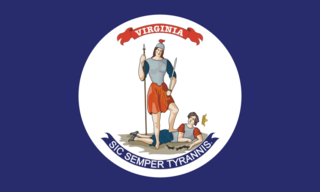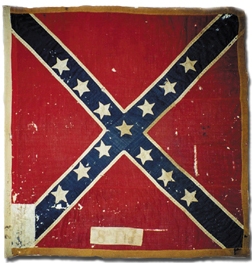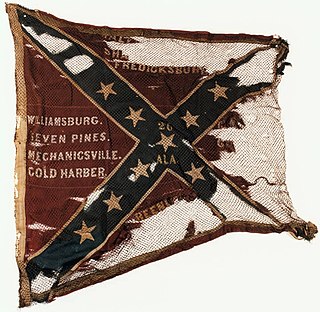
The Army of Northern Virginia was the primary military force of the Confederate States of America in the Eastern Theater of the American Civil War. It was also the primary command structure of the Department of Northern Virginia. It was most often arrayed against the Union Army of the Potomac.
The 50th Georgia Volunteer Infantry was an infantry regiment raised by the state of Georgia to fight for the Confederacy in the American Civil War.

Lafayette McLaws was a United States Army officer and a Confederate general in the American Civil War. He served at Antietam and Fredericksburg, where Robert E. Lee praised his defense of Marye's Heights, and at Gettysburg, where his division made successful assaults through the Peach Orchard and Wheatfield, but was unable to dislodge Union forces from Cemetery Ridge. After the Knoxville Campaign, he was court-martialed for inefficiency, though this was overturned for procedural reasons. Finally he was sent to his native Georgia to resist Sherman's March to the Sea, but had to retreat through the Carolinas, losing many men through desertion, and is presumed to have surrendered with Joseph E. Johnston in April 1865.

John Doby Kennedy was a general in the Confederate States Army during the American Civil War, as well as a post-war planter, attorney, politician, and the 57th Lieutenant Governor of South Carolina serving under Governor Johnson Hagood.

James Dearing was a Confederate States Army officer during the American Civil War who served in the artillery and cavalry. Dearing entered West Point in 1858 and resigned on April 22, 1861 when Virginia seceded from the Union. Dearing was mortally wounded at the Battle of High Bridge during the Appomattox Campaign of 1865, making him one of the last officers to die in the war. Despite serving as a commander of a cavalry brigade and using the grade of brigadier general after he was nominated to that grade by Confederate President Jefferson Davis, Dearing did not officially achieve the grade of brigadier general because the Confederate Senate did not approve his nomination. His actual permanent grade was colonel.
The Texas Brigade was an infantry formation that distinguished itself in the American Civil War. Along with the Stonewall Brigade, they were considered the Confederate Army's shock troops. It fought in every major battle of the Eastern Theater except Chancellorsville.

Hampton's Legion was an American Civil War military unit of the Confederate States of America, organized and partially financed by wealthy South Carolina planter Wade Hampton III. Initially composed of infantry, cavalry, and artillery battalions, elements of Hampton's Legion participated in virtually every major campaign in the Eastern Theater, from the first to the last battle.

The Cavalry Corps of the Army of Northern Virginia was an organized unit of cavalry in the Confederate Army during the American Civil War. Starting out as a brigade in late 1861, becoming a division in 1862 and finally a Corps in 1863; it served in the Eastern Theater until the ANV's surrender in April 1865.
A. P. Hill's Light Division was an infantry division in General Robert E. Lee's Confederate Army of Northern Virginia during the American Civil War. Originally including six brigades, the Division's first commander starting May 27, 1862 was then Major General A. P. Hill. Major Generals William Dorsey Pender and Cadmus M. Wilcox commanded a reorganized Light Division in the Army of Northern Virginia after Hill's promotion to corps command and Pender's death at the Battle of Gettysburg, respectively.

John Bratton was a U.S. Representative from South Carolina, as well as a general in the Confederate States Army during the American Civil War. He rose from private to brigadier general and led a regiment and brigade in the Army of Northern Virginia in several important battles in both the Eastern Theater and Western Theater during the war.
The 24th Georgia Volunteer Infantry was an infantry regiment in the Confederate States Army during the American Civil War. The regiment was part of Thomas Cobb's brigade at the Battle of Fredericksburg.

The 18th Georgia Volunteer Infantry was an infantry regiment in the Confederate Army during the American Civil War. Originally brigaded with the three Texas regiments of John Bell Hood's Texas Brigade, it was transferred to Thomas R.R. Cobb's Georgia Brigade after the Battle of Antietam in late 1862. After General Cobb was mortally wounded at the Battle of Fredericksburg, the original colonel of the 18th Georgia, William T. Wofford, became Brigadier General of the Georgia Brigade.

The 2nd Florida Infantry Regiment was an infantry regiment that fought in service of the Confederate States Army in the American Civil War.

The 15th Virginia Volunteer Infantry Regiment was an infantry regiment raised in Virginia for service in the Confederate States Army during the American Civil War. It fought mostly with the Army of Northern Virginia.

The 24th Virginia Volunteer Infantry Regiment was an infantry regiment raised in southwestern Virginia for service in the Confederate States Army during the American Civil War. It fought throughout the conflict, mostly with the Army of Northern Virginia. The 24th Virginia's most prominent field officers were Colonels Jubal A. Early and William R. Terry; Lieutenant Colonels Peter Hairston, Jr. and Richard L. Maury; and Majors William W. Bentley, Joseph A. Hambrick, and J.P. Hammet.

Also known as Law’s Brigade, the Alabama Brigade was a military formation of the Confederate States Army during the American Civil War. It was created in 1863 and participated in major combat operations such as the Battle of Gettysburg, the Battle of Chickamauga, the Battle of the Wilderness and the Richmond-Petersburg Campaign. It was considered one of the great fighting brigades of the Army of Northern Virginia.

The 8th Florida Infantry Regiment was a unit of the Confederate States Army during the American Civil War. Serving in the Army of Northern Virginia throughout the war; it fought in most battles of the Eastern Theater.

The 26th Alabama Infantry Regiment was an infantry regiment of the Confederate States Army regiment during the American Civil War. The regiment was composed of ten companies that came from various counties across Alabama. It is one of the few regiments that served both in the Army of Northern Virginia and Army of Tennessee.
The 15th Georgia Infantry Regiment was an infantry regiment in the Confederate States Army during the American Civil War. It participated in most of the key battles of Robert E. Lee's Army of Northern Virginia.

The 2nd South Carolina Infantry, also known as 2nd Palmetto Regiment, was Confederate States Army regiment in the American Civil War.













